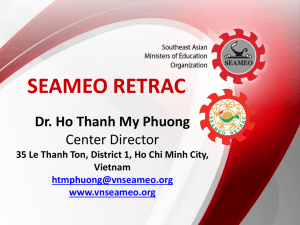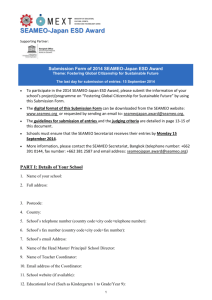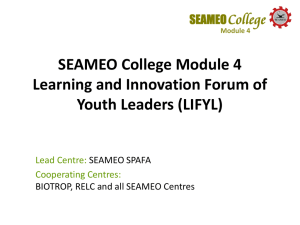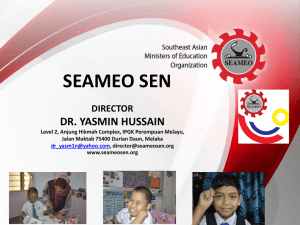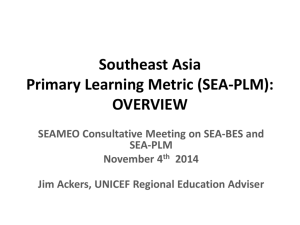2015_SubmissionForm_SEAMEO-Japan ESD
advertisement
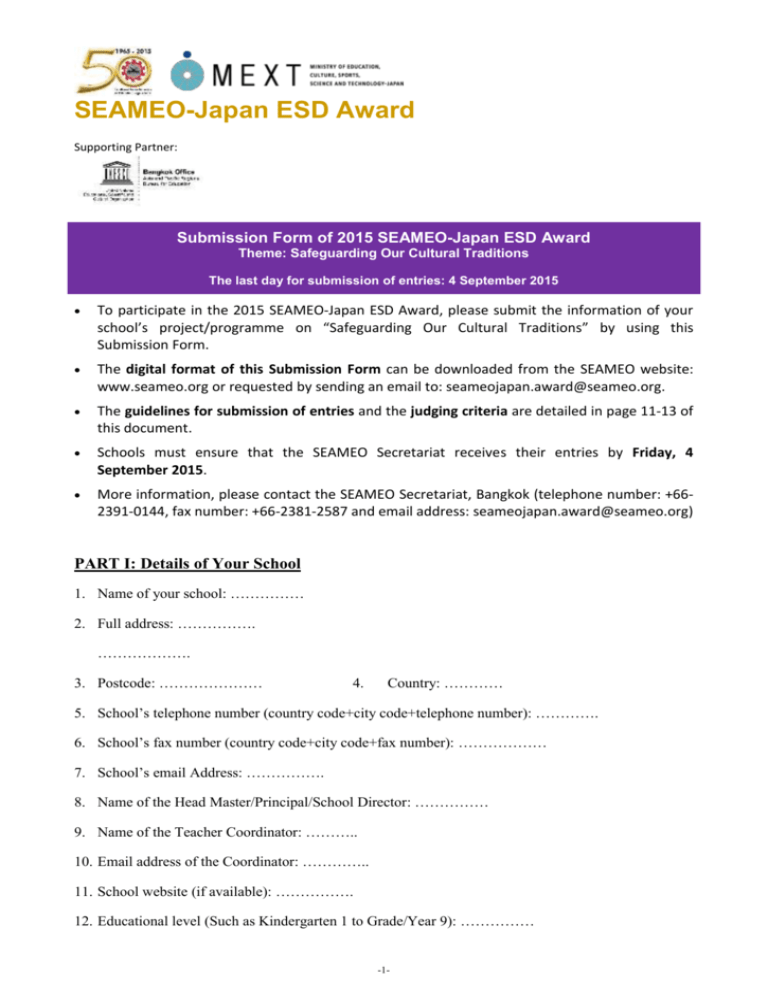
SEAMEO-Japan ESD Award Supporting Partner: Submission Form of 2015 SEAMEO-Japan ESD Award Theme: Safeguarding Our Cultural Traditions The last day for submission of entries: 4 September 2015 To participate in the 2015 SEAMEO-Japan ESD Award, please submit the information of your school’s project/programme on “Safeguarding Our Cultural Traditions” by using this Submission Form. The digital format of this Submission Form can be downloaded from the SEAMEO website: www.seameo.org or requested by sending an email to: seameojapan.award@seameo.org. The guidelines for submission of entries and the judging criteria are detailed in page 11-13 of this document. Schools must ensure that the SEAMEO Secretariat receives their entries by Friday, 4 September 2015. More information, please contact the SEAMEO Secretariat, Bangkok (telephone number: +662391-0144, fax number: +66-2381-2587 and email address: seameojapan.award@seameo.org) PART I: Details of Your School 1. Name of your school: …………… 2. Full address: ……………. ………………. 3. Postcode: ………………… 4. Country: ………… 5. School’s telephone number (country code+city code+telephone number): …………. 6. School’s fax number (country code+city code+fax number): ……………… 7. School’s email Address: ……………. 8. Name of the Head Master/Principal/School Director: …………… 9. Name of the Teacher Coordinator: ……….. 10. Email address of the Coordinator: ………….. 11. School website (if available): ……………. 12. Educational level (Such as Kindergarten 1 to Grade/Year 9): …………… -1- 13. Total number of teachers in your school: ………… 14. Approximately number of teachers participated in this programme: ………. 15. Total number of students in your school: ………. 16. Approximate number of students participated in this programme: ………. PART II: Information about the School’s Programme The information of part II from no.1 to 13 should be no longer than nine (9) pages long of A4 in total. The information should be written in Times New Roman font, 11-12 point size. 1. Title of the school’s programme 2. Summary of the programme (one half-page of A4 sheet size) -2- 3. Background information or reasons why the school created this programme 4. Objectives/goals of the programme 5. Brief details about the cultural traditions the school aims for within the programme and its values 5.1 Brief details about the cultural traditions the school aim for within the programme -3- 5.2 Please identify values that students have learned/gained from the cultural traditions as in 5.1 6. Period of the time when the programme was/has been started 7. Activities (Actions and strategies of implementation) -4- -5- 8. Teaching and learning approaches that the school applies for safeguarding cultural traditions as identified in point 5. 9. Participation with the community (Brief details of activities) -6- 10. Engagement of partners (Please provide the name of your partners in this programme and their roles/contributions) Name of Partners Roles and Contributions (Please add more row if it is necessary) 11. Monitoring and evaluation mechanisms and summary of results Monitoring and evaluation mechanisms: Summary of results: 12. Resources used for programme implementation -7- 13. Benefits/Impacts/ positive outcomes of the programme to students, school and the wider community 14. Plan for sustainability and plan for the future Plan for sustainability: -8- Plan for the future: 15. List of supporting documents such as a copy of the school operational plan or school management plan, action plan, learning/ teaching materials, lesson plans, samples of student worksheet, manuals, etc. If the supporting documents are in the local language, please provide a brief description in English language. Document 1) (File name)………. Document 2) …………….. Document 3) …………….. Document 4) ……………. Document 5) …………. … Document 6) ……………. 16. Photos related to the activity/programme (Maximum of 5 photos with captions in English) Photo1 (Caption in English) -9- Photo 2 (Caption in English) Photo 3 (Caption in English) Photo 4 (Caption in English) -10- Photo 5 (Caption in English) -11- SEAMEO-Japan ESD Award Supporting Partner: Guidelines for Submission of Entries 1. Schools can submit information about the school’s programme/project/activity related to the theme “Safeguarding Our Cultural Traditions” between 1 June to 4 September 2015. 2. The deadline of entry submissions is Friday, 4 September 2015. (The schools must ensure that the SEAMEO Secretariat receives entries by 4 September 2015.) 3. Each school can submit only one entry. 4. The submission of the school’s programme must be done through the template “Submission Form of 2015 SEAMEO-Japan ESD Award”. The Submission Form can be downloaded from the SEAMEO website: www.seameo.org or requested by sending an email to the email address: seameojapan.award@seameo.org. 5. Regarding the submission of information, each school must adhere to the following format, as specified in the Submission Form: a) Part I - Information about the school; 1) School name and contact details 2) Brief information about the school such as number of teachers and students and educational level 3) Contact details of the coordinator b) Part II - Information about the school’s programme; 1) Title of the school’s programme 2) Summary of the programme (one half-page of A4 sheet size) 3) Background information or reasons why the school created the programme 4) Objectives/goals of the programme 5) Brief details about the cultural traditions the school aims for within the programme and its values 6) Period of time when the programme was/has been started 7) Activities (Actions and strategies of implementation) 8) Teaching and learning approaches that the school applies for safeguarding cultural traditions as identified in point 5 9) Participation with the community 10) Engagement of partners 11) Programme monitoring and evaluation mechanisms and summary of results 12) Resources used for programme implementation -12- 13) Benefits/impacts/positive outcomes of the programme to students, school and the wider community 14) Plan for sustainability and plan for the future 15) List of supporting documents such as a copy of the school operational plan, action plan, learning/teaching materials, lesson plans, samples of student worksheet, manuals, etc. 16) Photographs related to the school programme (maximum of five photographs with captions written in English) 6. Information about the school programme (Part II as above) should not be over nine (9) pages of A4 in total. The information should be written in Times New Roman font, 11-12 point size. (A half-to-one page A4 sheet size about the project overview should be included.) 7. Information about the school project and the photo captions must be in English. The teaching and learning materials can be in local languages, however a brief translation in English should be provided. 8. All submissions should include related photos. (A maximum of five photographs with captions written in English.) 9. Schools can submit the "Submission Form of 2015 SEAMEO-Japan ESD Award" and other supporting materials to the SEAMEO Secretariat by a) Email: seameojapan.award@seameo.org and/or b) Send a Compact Disc (CD) or handy drive containing the digital files of submission form and supporting documents to the following address by post. (In case of damage to the CD, the printed version of the submission form should also be included in the mailing package.) SEAMEO-Japan ESD Award SEAMEO Secretariat 920 Sukhumvit Road Klongtoey, Bangkok 10110 THAILAND 10. All entries submitted to the SEAMEO Secretariat will be acknowledged. If the school has not received any acknowledgement of the receipt from the SEAMEO Secretariat within one week after the submission, please contact the SEAMEO Secretariat (Email: seameojapan.award@seameo.org). Judging Criteria The judging committee will consider the following criteria in selecting the winning schools: 1. Strategy/ Modality of Implementation Conservation and promotion of cultural traditions is emphasized and incorporated into school policies, management plans, and teaching and learning programmes within the school. The school has ensured the continuous transfer of cultural traditions from one generation to the next of knowledge, skills and values embedded in cultural traditions, so as to help keep a practice alive and relevant to the communities or groups who practice it. The school has demonstrated the use of participatory processes – involving students, teachers, parents, community stakeholders and partners – in planning and implementing the programme. Appropriate and effective methods and resources are used to implement the programme. Monitoring and evaluation mechanisms or processes are identified to safeguard the immediate and long-term outcomes of the programme. 2. Innovation and Creativity The school’s programme has demonstrated innovative practices in safeguarding local cultural traditions. The school has demonstrated innovative ideas for utilizing available resources. -13- The entry is a new idea or an improved/adapted version of existing activities. 3. Teaching and Learning Approaches The school has demonstrated effective teaching and learning approaches that have been applied to the preservation and safeguarding of cultural traditions. The school has embedded knowledge about cultural traditions into subject disciplines and incorporated ESD principles and pedagogical methods to ensure that students are able to connect the practices in their community, in their local environment, materials and resources, and learn more effectively. Teacher capacity building programmes have been conducted to ensure that teachers are able to integrate values, skills and knowledge of cultural traditions and ESD into their lesson plans, and use appropriate teaching and learning methods and classroom-community links. 4. Engagement of Multisectoral Partners The school has engaged multi-sectoral partners such as education institutions, teacher-training institutions, schools, cultural institutions and professional associations to co-implement the school’s programme. The school has engaged community-level partners such as community stakeholders, experts, cultural bearers, elders, local leaders, practitioners and parents who provide information and guidance on local cultural traditions. The school’s programme has strengthened student involvement in the local community. 5. Sustainability The school has demonstrated a clear future plan on how to sustain the programme. The school has integrated cultural tradition practices within the school management plan and teaching and learning activities across subjects for a long-term action strategy. 6. Impact Results, during/after implementation, have revealed the effectiveness and benefits of the school’s programme to students, teachers, parents and the wider community. Information collected about cultural traditions has been effectively compiled, documented, and shared within the schools, between schools in one area, and at the broader provincial or national levels. Contact Information For enquiry, please contact: SEAMEO-Japan ESD Award SEAMEO Secretariat 920 Sukhumvit Road Klongtoey, Bangkok 10110 THAILAND Email: seameojapan.award@seameo.org Website: www.seameo.org Tel: +66-2391-0144 Fax: +66-2381-2587 -14-
